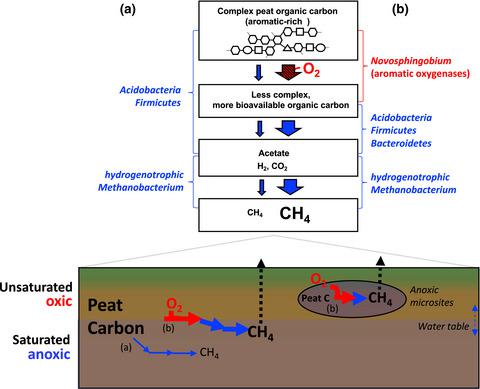当前位置:
X-MOL 学术
›
Glob. Change Biol.
›
论文详情
Our official English website, www.x-mol.net, welcomes your feedback! (Note: you will need to create a separate account there.)
The role of oxygen in stimulating methane production in wetlands
Global Change Biology ( IF 11.6 ) Pub Date : 2021-08-18 , DOI: 10.1111/gcb.15831 Jared L Wilmoth 1 , Jeffra K Schaefer 2 , Danielle R Schlesinger 3 , Spencer W Roth 2 , Patrick G Hatcher 4 , Julie K Shoemaker 5 , Xinning Zhang 1, 3
Global Change Biology ( IF 11.6 ) Pub Date : 2021-08-18 , DOI: 10.1111/gcb.15831 Jared L Wilmoth 1 , Jeffra K Schaefer 2 , Danielle R Schlesinger 3 , Spencer W Roth 2 , Patrick G Hatcher 4 , Julie K Shoemaker 5 , Xinning Zhang 1, 3
Affiliation

|
Methane (CH4), a potent greenhouse gas, is the second most important greenhouse gas contributor to climate change after carbon dioxide (CO2). The biological emissions of CH4 from wetlands are a major uncertainty in CH4 budgets. Microbial methanogenesis by Archaea is an anaerobic process accounting for most biological CH4 production in nature, yet recent observations indicate that large emissions can originate from oxygenated or frequently oxygenated wetland soil layers. To determine how oxygen (O2) can stimulate CH4 emissions, we used incubations of Sphagnum peat to demonstrate that the temporary exposure of peat to O2 can increase CH4 yields up to 2000-fold during subsequent anoxic conditions relative to peat without O2 exposure. Geochemical (including ion cyclotron resonance mass spectrometry, X-ray absorbance spectroscopy) and microbiome (16S rDNA amplicons, metagenomics) analyses of peat showed that higher CH4 yields of redox-oscillated peat were due to functional shifts in the peat microbiome arising during redox oscillation that enhanced peat carbon (C) degradation. Novosphingobium species with O2-dependent aromatic oxygenase genes increased greatly in relative abundance during the oxygenation period in redox-oscillated peat compared to anoxic controls. Acidobacteria species were particularly important for anaerobic processing of peat C, including in the production of methanogenic substrates H2 and CO2. Higher CO2 production during the anoxic phase of redox-oscillated peat stimulated hydrogenotrophic CH4 production by Methanobacterium species. The persistence of reduced iron (Fe(II)) during prolonged oxygenation in redox-oscillated peat may further enhance C degradation through abiotic mechanisms (e.g., Fenton reactions). The results indicate that specific functional shifts in the peat microbiome underlie O2 enhancement of CH4 production in acidic, Sphagnum-rich wetland soils. They also imply that understanding microbial dynamics spanning temporal and spatial redox transitions in peatlands is critical for constraining CH4 budgets; predicting feedbacks between climate change, hydrologic variability, and wetland CH4 emissions; and guiding wetland C management strategies.
中文翻译:

氧气在刺激湿地甲烷产生中的作用
甲烷 (CH 4 ) 是一种强效温室气体,是继二氧化碳 (CO 2 ) 之后导致气候变化的第二大温室气体。湿地中 CH 4的生物排放是CH 4预算中的主要不确定性。古生菌的微生物产甲烷是一种厌氧过程,占自然界中大多数生物 CH 4的产生,但最近的观察表明,大量排放可能来自含氧或经常含氧的湿地土壤层。为了确定氧气 (O 2 ) 如何刺激 CH 4排放,我们使用泥炭土的孵化来证明泥炭暂时暴露于 O 2在随后的缺氧条件下,相对于没有 O 2暴露的泥炭, CH 4产量可以提高 2000 倍。泥炭的地球化学(包括离子回旋共振质谱、X 射线吸收光谱)和微生物组(16S rDNA 扩增子、宏基因组学)分析表明,氧化还原振荡泥炭的较高 CH 4产量是由于氧化还原过程中泥炭微生物组的功能变化所致振荡增强了泥炭碳(C)的降解。与缺氧对照相比,在氧化还原振荡泥炭的氧化期间,具有 O 2依赖性芳香加氧酶基因的新鞘氨醇物种的相对丰度大大增加。酸杆菌物种对泥炭 C 的厌氧处理特别重要,包括产甲烷底物 H 2和 CO 2。在氧化还原振荡泥炭的缺氧阶段,较高的 CO 2产生刺激了甲烷杆菌物种的氢营养 CH 4产生。在氧化还原振荡泥炭中长时间氧化期间还原铁(Fe(II))的持续存在可能通过非生物机制(例如,芬顿反应)进一步增强C降解。结果表明,泥炭微生物组的特定功能转变是酸性泥炭藓中 CH 4产生的 O 2增强的基础。- 丰富的湿地土壤。他们还暗示,了解泥炭地中跨越时间和空间氧化还原转变的微生物动态对于限制 CH 4预算至关重要。预测气候变化、水文变率和湿地 CH 4排放之间的反馈;指导湿地 C 管理策略。
更新日期:2021-10-15
中文翻译:

氧气在刺激湿地甲烷产生中的作用
甲烷 (CH 4 ) 是一种强效温室气体,是继二氧化碳 (CO 2 ) 之后导致气候变化的第二大温室气体。湿地中 CH 4的生物排放是CH 4预算中的主要不确定性。古生菌的微生物产甲烷是一种厌氧过程,占自然界中大多数生物 CH 4的产生,但最近的观察表明,大量排放可能来自含氧或经常含氧的湿地土壤层。为了确定氧气 (O 2 ) 如何刺激 CH 4排放,我们使用泥炭土的孵化来证明泥炭暂时暴露于 O 2在随后的缺氧条件下,相对于没有 O 2暴露的泥炭, CH 4产量可以提高 2000 倍。泥炭的地球化学(包括离子回旋共振质谱、X 射线吸收光谱)和微生物组(16S rDNA 扩增子、宏基因组学)分析表明,氧化还原振荡泥炭的较高 CH 4产量是由于氧化还原过程中泥炭微生物组的功能变化所致振荡增强了泥炭碳(C)的降解。与缺氧对照相比,在氧化还原振荡泥炭的氧化期间,具有 O 2依赖性芳香加氧酶基因的新鞘氨醇物种的相对丰度大大增加。酸杆菌物种对泥炭 C 的厌氧处理特别重要,包括产甲烷底物 H 2和 CO 2。在氧化还原振荡泥炭的缺氧阶段,较高的 CO 2产生刺激了甲烷杆菌物种的氢营养 CH 4产生。在氧化还原振荡泥炭中长时间氧化期间还原铁(Fe(II))的持续存在可能通过非生物机制(例如,芬顿反应)进一步增强C降解。结果表明,泥炭微生物组的特定功能转变是酸性泥炭藓中 CH 4产生的 O 2增强的基础。- 丰富的湿地土壤。他们还暗示,了解泥炭地中跨越时间和空间氧化还原转变的微生物动态对于限制 CH 4预算至关重要。预测气候变化、水文变率和湿地 CH 4排放之间的反馈;指导湿地 C 管理策略。



























 京公网安备 11010802027423号
京公网安备 11010802027423号